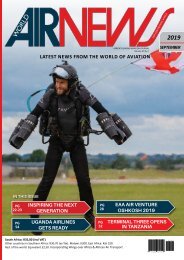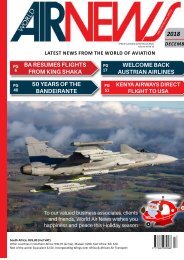World AirNews June 2018
- No tags were found...
You also want an ePaper? Increase the reach of your titles
YUMPU automatically turns print PDFs into web optimized ePapers that Google loves.
ILA BERLIN<br />
NEWS DIGITAL<br />
Small South African University Fosters<br />
Innovation and Safety in General Aviation<br />
SA STUDENTS USE ICT TO<br />
PROPEL AVIATION SECTOR<br />
By Candice Turner<br />
Manned-UnManned<br />
TeaMing CapabiliTies<br />
deMOnsTRaTed<br />
A<br />
IRBUS HELICOPTERS and Schiebel have tested Manned<br />
Unmanned Teaming (MUM-T) capabilities between an<br />
H145 platform and a CAMCOPTER S-100 Unmanned Air System<br />
(UAS), becoming the first European helicopter manufacturer to<br />
demonstrate this technology with the highest level of interoperability.<br />
(LOI°5).<br />
The companies carried out test flights with the support of the<br />
Austrian Armaments and Defence Technology Agency.<br />
The two aircraft jointly flew different scenarios including the<br />
detection of objects hidden in places not accessible by traditional<br />
helicopters. The S-100 was controlled and piloted by an operator<br />
sitting in the helicopter. During the flights, the control was also<br />
temporarily handed over to a ground-based control station by the<br />
pilot in order to simulate the return of the manned helicopter for<br />
refuelling.<br />
The trials carried out by Airbus Helicopters and Schiebel went<br />
up to MUM-T LOI 5. This allows the manned platform to exercise<br />
full control of the UAS including its take-off and landing. LOI 1, the<br />
lowest level, is the indirect receipt and /or transmission of sensor<br />
data obtained by the UAS to the manned aircraft.<br />
“Manned-Unmanned Teaming multiplies the capabilities of both<br />
systems”, said Mark R.Henning programme manager at Airbus<br />
Helicopters. “Smaller UAS with vertical take-off and landing<br />
capabilities can, for example, fly around obstacles such as trees or<br />
buildings closer than a helicopter could. They are able to explore<br />
unknown territory and deliver information to the helicopter crew<br />
which is operating from a safe position and which can then step<br />
in with the helicopter’s superior effects, having received a clear<br />
picture from the UAS.<br />
“Our airborne MUM-T management system will become a highly<br />
attractive feature for our entire product range including the NH90,<br />
NFH, and the Tiger together with the H145 as it adds an extremely<br />
valuable operational capability. The MUM-T capability can be implemented<br />
in any kind of helicopter and can interact with all types<br />
of unmanned systems, in particular Airbus Helicopters’ new VSR<br />
700 UAS,” Henning explained.<br />
In the framework of the test, the challenges of data transfer<br />
interference and electromagnetic compatibility of the UAS with<br />
the helicopter, as well as the integration of a complete UAS mission<br />
planning and control system into the helicopter’s architecture<br />
were successfully managed. The S-100 mission planning and control<br />
system was provided by Schiebel.<br />
The next step will be to optimize the human machine interface<br />
based on a thorough analysis of the crew workload using the results<br />
of the flight tests. Q<br />
N<br />
EVER UNDERESTIMATE the creativity and potential of a<br />
young mind. These were the words Jan Rombouts, the<br />
Chairman of Belgium Campus, told teachers and students recently<br />
while they were sitting in an airplane hangar in Pretoria, built for<br />
an innovative group of technology students.<br />
Located on the outskirts of Pretoria, the Technology University<br />
is a far cry from sheer scale of the headquarters or innovation hub<br />
for Tesla or even Blue Origin. And yet, it is here, in a small South<br />
African suburb, that the future of aviation is emerging.<br />
When one meets the chairman and his young team of whizz kids,<br />
top of mind is a question of why an IT University is building an<br />
aircraft? “IT has become a part of everything,” Rombouts begins,<br />
tinkering with some cables on the aircraft’s wing. “The world runs<br />
on innovative ideas and ICT is the platform that endorses the<br />
manifestation of these ideas. Information Technology is, after all,<br />
an enabler.”<br />
True, one of the greatest credos of this age of technology has<br />
to be the dexterity with which IT adapts to other disciplines. And<br />
here, in this remarkable hanger-come-workshop, it becomes ever<br />
apparent. The chairman and project leader goes on to explain how<br />
the students at Belgium Campus have been fortunate enough to<br />
work with top universities and companies across the globe, from<br />
the United States to Australia; from developing facial recognition<br />
technology for drones to innovation projects with Boeing and<br />
Lockheed Martin. “As an aviator myself, and someone who thrives<br />
on innovation, we sat together as a team when we had come back<br />
from a recent project with Boeing and seriously began to consider<br />
the possibility of building our very own plane, and here we are<br />
today.”<br />
ENVIRONMENT TO FLOURISH<br />
Walking through the hangar, the team of students pointed out the<br />
other innovations currently underway and how no expense had<br />
been spared to ensure they have everything they need to explore<br />
their ideas and visions; illustrating the university’s passion for the<br />
ICT sector and the kinetic power and influence at its command.<br />
The management and academic team believe that through empowering<br />
their students to innovate and revolutionise their worlds,<br />
many more astonishing solutions flow through the campus that will<br />
greatly benefit every type of industry and sector.<br />
One such undertaking is their Aeronautics Project where<br />
students are given access to the field of aeronautics and have a<br />
full-scale airport hangar at their disposal. “They’ve explored every-<br />
<strong>World</strong> Airnews | <strong>June</strong> Extra <strong>2018</strong><br />
— 11—<br />
<strong>World</strong> Airnews | <strong>June</strong> Extra <strong>2018</strong><br />
— 12 —





